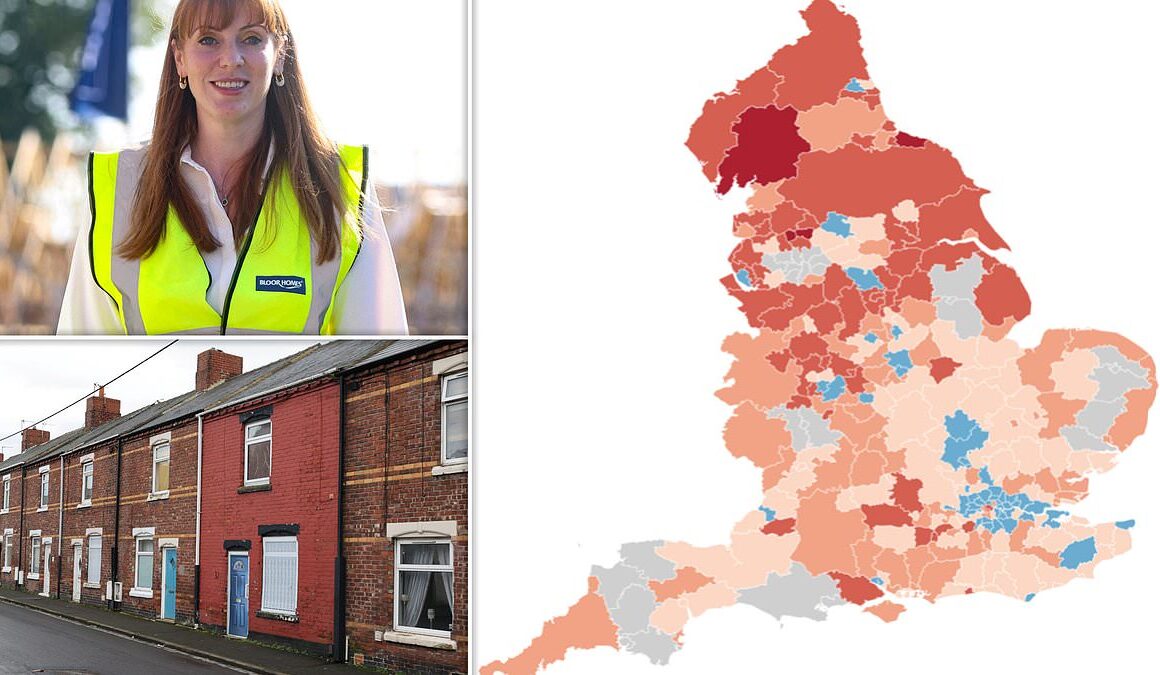Labour’s plans for 1.5million new homes have led to fears thousands of extra houses will be built in ‘declining’ former industrial towns where there is little demand.
Deputy PM Angela Rayner this week unveiled her bid for 370,000 extra homes per year in England as she confirmed the return of top-down housing targets for local councils.
These will be calculated using a new method that will include an ‘uplift’ in the most unaffordable areas.
But experts have warned the new method will actually be ‘brutally punitive to communities that have declined’ and where ‘extra housing is least needed’.
This includes areas that were ‘big during the Industrial Revolution’ but have since ‘shrunk’.
Under Labour’s plans, the former mining town of Burnley will be handed a target of 369 extra homes per year under the proposed new method.
This is up from 51 under the current method, which was first introduced in 2018.
Some former mining areas in England have been dubbed ‘ghost towns’ in recent years due to their declining populations and streets with boarded-up empty properties.
Burnley Council estimated the Lancashire town had 1,731 empty properties in 2023, which it warned are ‘vulnerable to break-ins by squatters, vandals, drug dealers and arsonists’ and ‘create a negative impact on the local environment’.
The local authority has tasked an ’empty property team’ with tackling these issues and to ‘encourage the owners of empty properties to bring these much needed homes back in to occupation’.

Deputy PM Angela Rayner this week unveiled her bid for 370,000 extra homes per year in England as she confirmed the return of top-down housing targets for local councils

Burnley Council estimated the Lancashire town had 1,731 empty properties in 2023. Pictured: A 2010 image of boarded up terraced houses in Burnley earmarked for new modern housing

A boarded-up home is plastered with fake windows and doors in Horden, County Durham

One empty home in Horden had the words ‘rent me’ rubbed onto the front window
Under Labour’s new method for calculating housing targets, Redcar’s target has also jumped considerably from 45 to 642, Hyndburn from 50 to 313, Hartlepool from 157 to 388, Kingston upon Hull from 536 to 1,053, and County Durham from 1,129 to 2,210.
In total, Labour’s new housing targets for the North East are almost double those under the current method – an increase of 99 per cent.
Targets for the North West will increase by 76 per cent, while Yorkshire and The Humber is being asked to increase their targets by 47 per cent.
But targets for London will actually drop by 18 per cent, in a significant reduction for the capital.
Robert Colvile, director of the CPS think tank, said: ‘The new housing formula is delivering huge housing uplifts in the parts of the country where (statistically) housing is most affordable and extra housing is least needed.
‘The new formula basically asks councils to expand their housing stock by 0.8 per cent a year (slightly under the average over the last 10 years), multiplied by the new adjustment factor used to account for affordability.
‘But this is brutally punitive to communities that have declined or are declining. In particular, places that were big during the Industrial Revolution, have shrunk since – but still have all the housing stock from when they had industry/population.’
He noted how, in 2020, the previous Tory government dropped controversial planning reforms due to a backlash over an update to the ‘mutant algorithm’ used to calculate local targets.
‘Many councils will feel this new formula is the mutant algorithm on steroids – because the shift from households to stock has resulted in wild swings in numbers,’ he added.
‘But crucially, it is also set to build many, many new homes in the places where they are least needed.
‘Luckily, the new measures – which have obviously been rushed out – are still being consulted on.
‘There is still time to fix the formula and ensure that planning reform – which remains absolutely vital – both delivers housing where it’s most needed, and retains public consent.’
Samuel Hughes, a research fellow at the University of Oxford and head of housing at the CPS, said: ‘Housing targets in the North have risen greatly.
‘This is a surprising move, generated by a shift from calculating need based on population growth (Northern populations are often flat or declining) to existing housing stock (Northern housing stock is relatively abundant).
‘The overall effect of the policy seems to have been to shift housing targets away from the areas where housing is most unaffordable and scarcity is most acute. Some rural areas are fairly unaffordable, but none is as unaffordable as London.
‘And the North broadly has good housing affordability, whatever other economic challenges it may face.’

In total, Labour’s new housing targets for the North East are almost double those under the current method – an increase of 99%. But targets for London will actually drop by 18%

Labour’s proposed new method for calculating local housing targets will include ‘an uplift where house prices are most out of step with local incomes’

Shadow housing secretary Kemi Badenoch asked Ms Rayner why she was 'reducing the need for cities like London to build more housing when they have the infrastructure to support it'
The Lichfields planning consultancy also warned that Labour's new method for calculating housing targets could have a distortive effect.
It said in an article on its website: 'The mandatory element and a 0.8 per cent stock-based starting point means a small number of locations (perhaps more remote areas or towns that have experienced de-industrialisation) will see high estimates of need alongside very low (or even negative) levels of household growth.
'In these locations, providing new housing as a flat percentage of stock may in some instances give rise to housing market displacement (similar to that which afflicted some areas of housing market renewal in the 1990s) or may prove not to be deliverable.'
Cllr Richard Clewer, housing and planning spokesman for the County Councils Network, said: 'The CCN will be consulting with its members on the new methodology for housing numbers, but we have always been clear that local authorities know their areas best and that housing should be fairly distributed across the entirety of the country.
'County areas have delivered 600,000 homes in the past five years – higher than the rest of the country combined.
'However, on face value, this new methodology assigns more to rural areas that currently do not have sufficient infrastructure and less to urban locations that have more readily available infrastructure.'
Responding to Ms Rayner's plans in the House of Commons this week, Tory shadow housing secretary Kemi Badenoch asked why Labour was 'reducing the need for cities like London to build more housing when they have the infrastructure to support it'.
'Why is she forcing suburban and rural areas to take more housing when there are schoools in Hackney... that are shutting down because they don't have enough pupils?,' she added.
The Ministry of Housing, Communities and Local Government said it would not 'shy away' from the fact there would be 'big increases' in local housing targets for some areas.
But it claimed these would bring local targets 'far more in line' with the number of new houses that are actually being built in some areas.
In a blogpost, MHCLG said 'a consistent criticism of the old method' was that it 'dragged down ambition in large areas of the North and Midlands, where targets fell radically short of existing delivery'.
'With houses out of reach for the average earner in all but two local authorities, ambitious growth should not be confined to the South East,' it added.
'We do not shy away from the fact that this drives some big increases versus current targets – in many cases this simply brings the output of the standard method far more in line with existing delivery.
'For example, County Durham, Darlington, Hartlepool, Middlesbrough, Northumberland, Stockton-on-Tees, Sunderland, and Redcar and Cleveland have delivered hundreds more homes per year than the target set for them.
'In some cases, the old method suggested an authority delivering hundreds of homes a year should only be delivering in the tens. The new targets compared to delivery are rightly ambitious yet credible.
'The new method strikes a balance between recognising and meeting the scale of need right across the country and focusing additional growth on those places facing the biggest affordability pressures, by more than doubling the affordability multiplier we apply in the method.'






